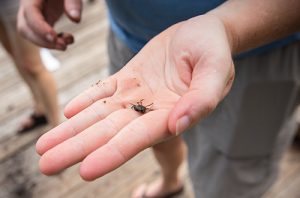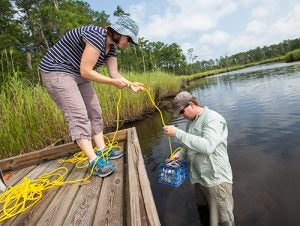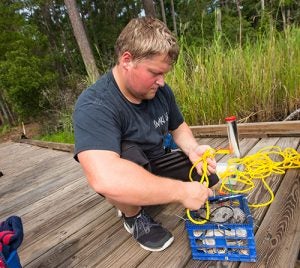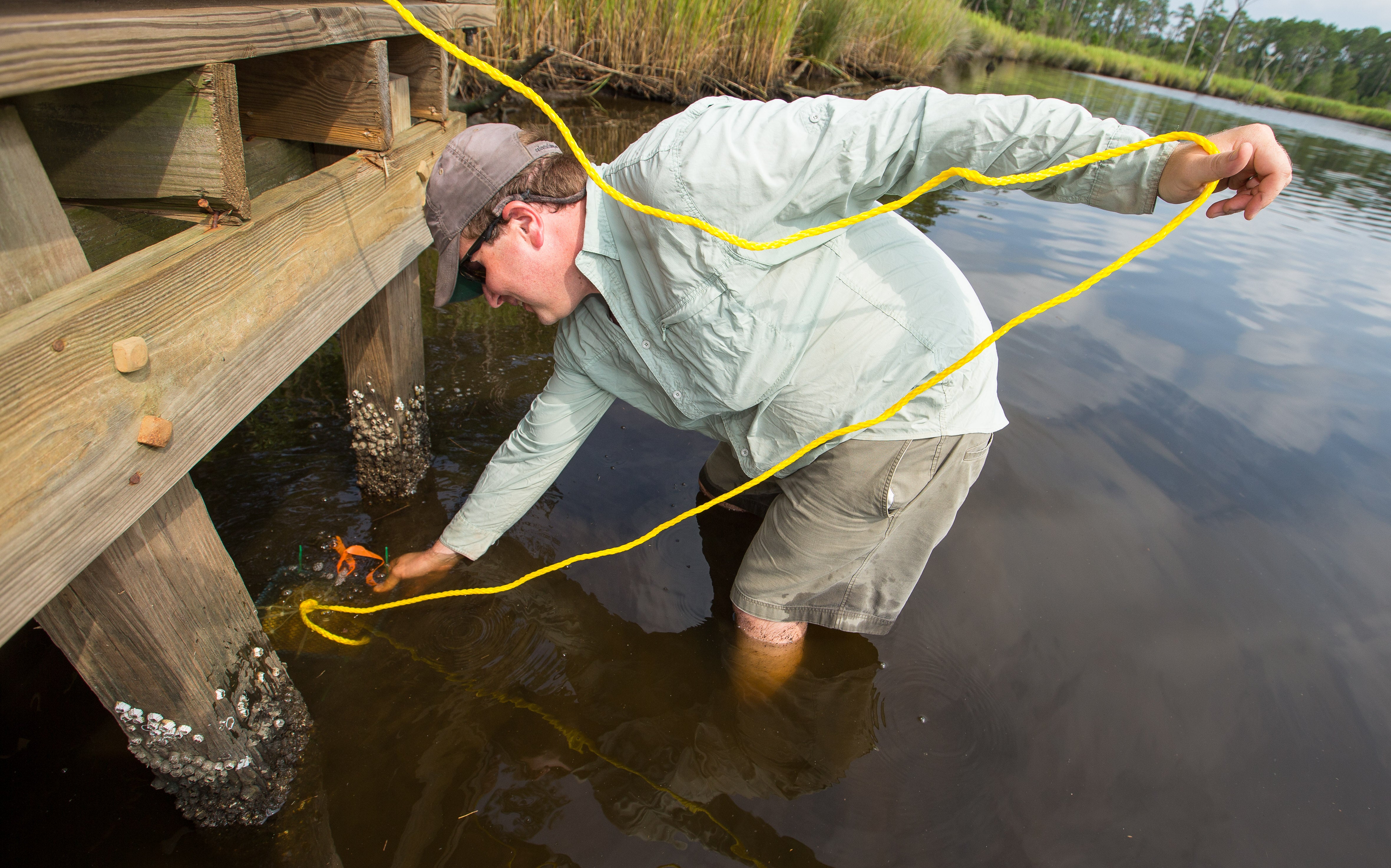SHELL SNATCHERS
Parasite hijacks mud crab life cycle
Researchers at East Carolina University are studying an invasive parasite that takes over the reproductive system of mud crabs and even alters their behavior, potentially impacting coastal ecosystems.
“It’s detrimental to the host crab because they can no longer reproduce their own young,” said Dr. April Blakeslee, assistant professor of biology. “We call it a body-snatching parasite because it takes over from throughout the inside of the crab.”
The parasite is a kind of barnacle, called Loxothylacus panopaei or Loxo for short, that is native to the Gulf of Mexico.
The female barnacle infects the host and spreads its roots, Blakeslee said, then produces an external sac containing thousands of eggs on the crab’s abdomen, which are fertilized by the male Loxo. “Once it does that the sac becomes larger and then the larvae are released into the water. So a few infected crabs can infect the rest of the population pretty quickly.”
Infected crabs continue living and feeding but are reproductively dead, earning them the nickname “zombie crabs.”
In the Gulf, where the mud crabs have developed some resistance to the parasite, infection rates are low (less than 5 percent), but in the Chesapeake Bay, where Loxo is considered an invasive species, infection rates may be as high as 75 or even 90 percent, Blakeslee said. It has also been found in waters all along the East Coast, as far north as Long Island Sound.
The parasite also affects the crab’s behavior, causing it to protect the egg sac as if it were the crab’s own young. The protective behavior is found not only in female crabs, but also in males, which would not normally exhibit such tendencies.
By hijacking the mud crabs’ reproductive system, Blakeslee said the parasite could have a dramatic impact on the population.

Mud crabs, which can be found in oyster beds and amongst woody debris, form an important link in the food chain.
“These mud crabs are very small, but they’re really important because they’re a huge part of the food web,” she said. “They are prey for things like blue crabs, lots of fish and birds. And in turn they eat tiny things within the oyster beds. Studies have shown that if you pull out these intermediate species, the whole system can fall apart.”
This month, Blakeslee and a team of students and collaborators deployed crab collector units at sites along the banks of the Pamlico and Neuse rivers to monitor the mud crab population and the prevalence of Loxo in coastal North Carolina waters.
“It’s not actually a trap because it allows the mud crabs … to go in and out,” Blakeslee said. “They’re small plastic milk crates, and we fill them with oyster shells, which are a great habitat for lots of different organisms, including the mud crabs.”
The collector units, or crab condos, as the team calls them, are usually deployed near docks, where they can be tied off and easily retrieved. Each condo has a device attached that records the water temperature on an hourly basis, and the researchers will measure the salinity monthly when they check the collector units.
As many as a few dozen mud crabs – or more if they’ve just reproduced – could take up residence in each of the crab condos.
The monitoring effort is based on work that has been done in the Chesapeake Bay by the Smithsonian Environmental Research Center since 2003. “Really it’s luxury compact crab living,” said Carolyn Tepolt, a post-doctoral student at SERC who helped deploy the collector units. “The crabs look for structure and shelter, somewhere that they won’t get eaten.”

Blakeslee and graduate student Christopher Moore deploy a crab collector unit, or crab condo, which contains oyster shells as a habitat for the mud crabs.
Sites were chosen upstream and downstream along the two river systems. “Starting at pretty much fresh and moving toward saltier water as you get closer to the Pamlico Sound and to the ocean, we’ll put [collector units] out at these different locations and see how that affects the densities of the mud crabs and the prevalence of the parasite,” Blakeslee said.
The hypothesis is that the crab has adapted to the parasite in a couple of different ways. “One is that it can resist infection by this parasite, and the other is that it can escape the parasite by being in really low salinity waters,” Blakeslee said. “The parasite doesn’t do as well in fresh water, so the crabs can basically find refuge there.
“If that holds true we will see less of the parasite as we move upstream.”
Blakeslee is working on a grant application to submit to the National Science Foundation to study that hypothesis throughout North America. She recently received one of 35 Ralph E. Powe Junior Faculty Enhancement Award from Oak Ridge Associated Universities, which provides $5,000 to support the North Carolina portion of the research. ECU will match the award in the same amount.
Ph.D. student Christopher Moore and undergraduate student Matt Ruocchio are assisting Blakeslee with the project.

Matt Ruocchio attaches a temperature logger to the crab condo.
Moore, who previously did environmental field work in the Chesapeake Bay for the state of Maryland, said it’s exciting to be in a new area, studying new habitats and species. “There are so many of these complex parasitic processes,” he said.
“Another part of our work is showing the impact of humans in moving things into places that they wouldn’t have been able to get to,” Blakeslee said. “Humans have been transplanting oysters for long periods of time, especially the early to mid-1900s, and we think that’s how this parasite has spread. The mud crabs are native here, but the parasite was completely absent before.”
Invasive species can also have a ripple effect. In Texas, the mud crabs have been found in freshwater lakes.
“We think the parasite may have helped fuel the crab’s evolution toward tolerance for low salinity, to the point that they have moved into these lakes and can live and reproduce in a freshwater system, where the crabs themselves are invasive, so it’s not a good thing for the lakes. But they’re completely parasite-free there because the parasite can’t live in fresh water.”
The researchers will continue to monitor the crab condos for the next year, providing a better idea of Loxo infection rates and the state of the mud crab population in North Carolina waters.

Collector units were deployed at sites on the Pamlico and Neuse rivers and will be checked monthly for a year.
